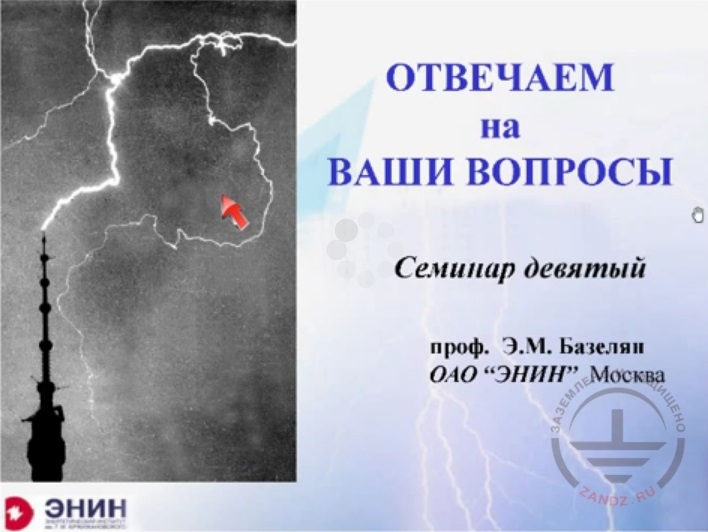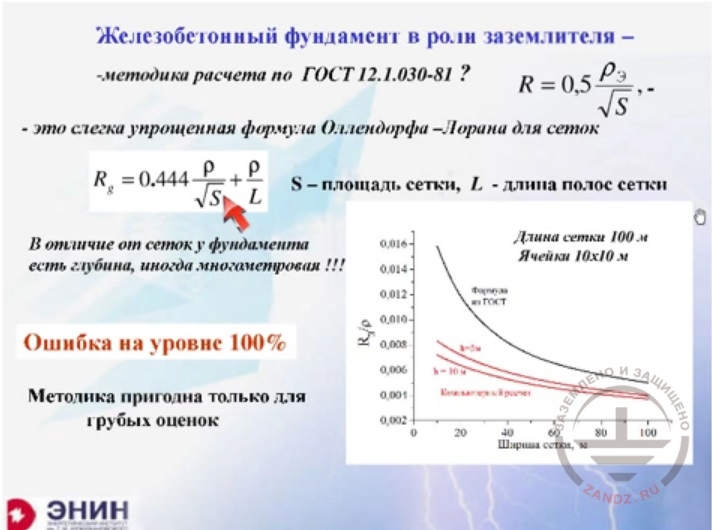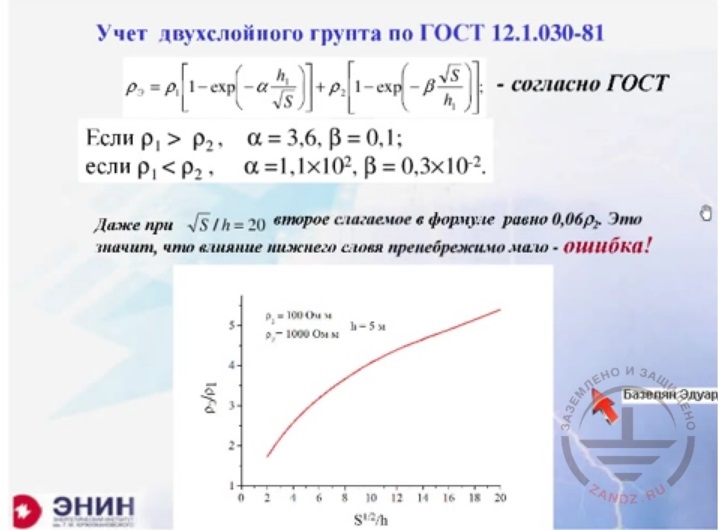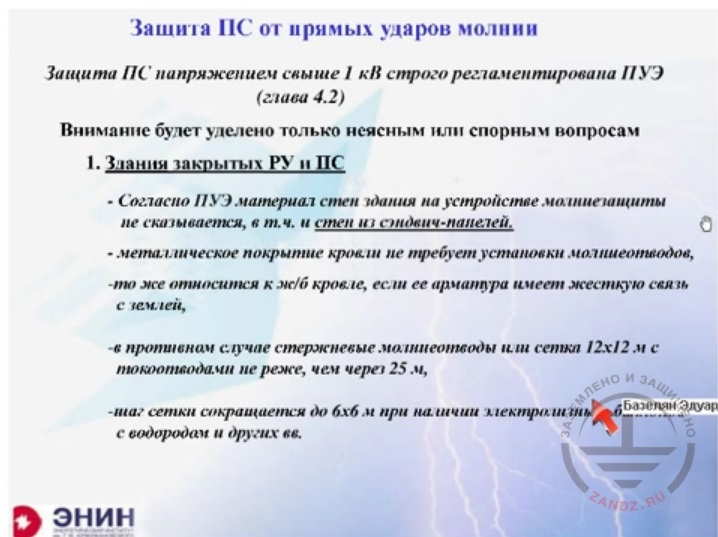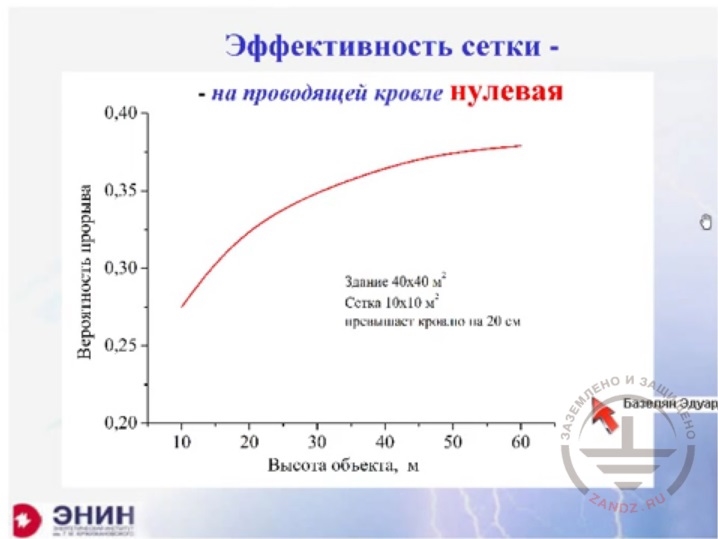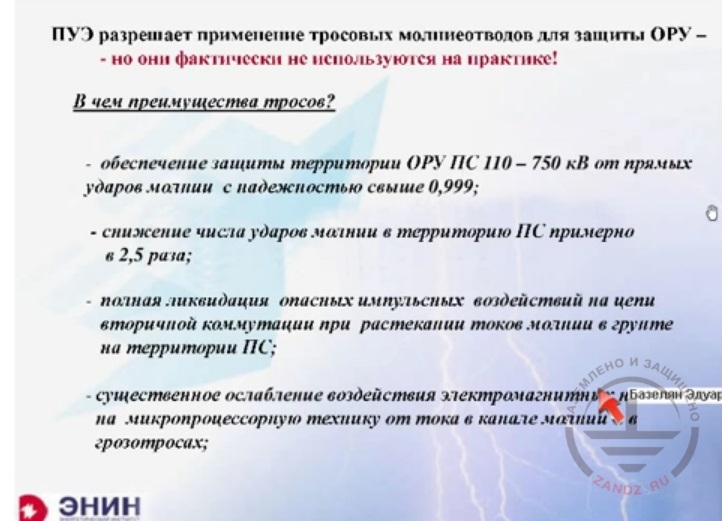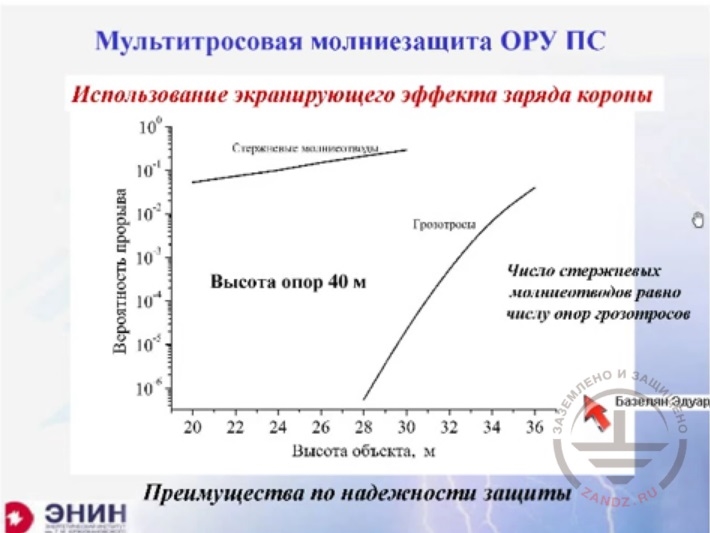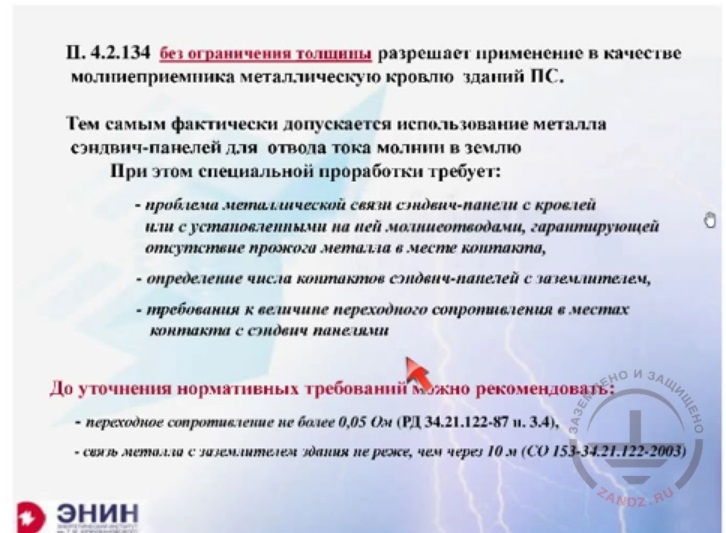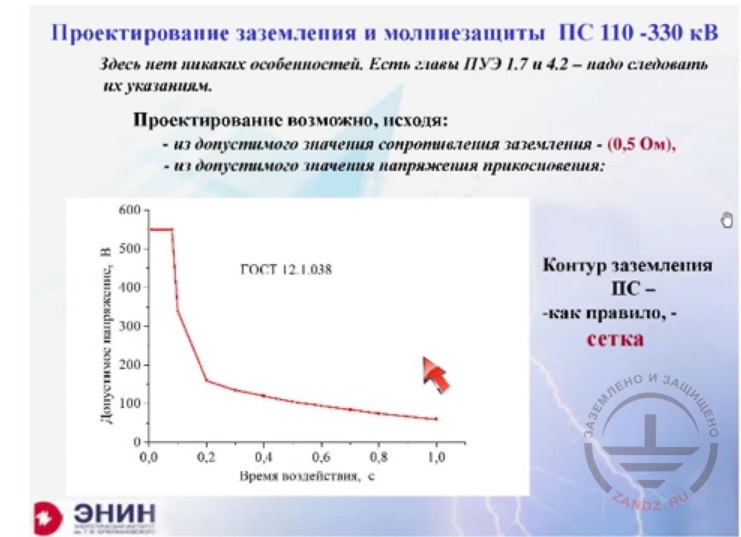The tenth webinar of the series "Grounding and lightning protection: questions and answers arising at the design"
(was held on 24 June 2015 at 11:00 Moscow time)
Full-screen mode with the quality of "720p" is recommended.
Having held eight webinars, we received a large number of questions and points for discussion and sorted them into groups. Here are some of them:
1. Energy facilities and substations:
- The design and structure of lightning rods installed on buildings with reinforced concrete roofing and the walls finished with sandwich panels on electrical substations (sometimes, there are no main walls behind the sandwich panels). Calculation method.
- External grounding on electrical substations (ESS). Calculation methods (not the software).
2. Telecommunication facilities:
- Designing lightning protection and grounding for server rooms and data centers.
- Designing the lightning protection and grounding of antenna-mast structures.
3. Sensitive medical equipment:
- Why a separate ground loop for the process of medical equipment is not required?
- Design features of supersensitive devices grounding.
4. Lightning protection of residential buildings:
- Lightning protection of public and residential buildings with the accessible roof (with swimming pools, cafeterias etc. on the roofs).
- How do you recommend to carry out lightning protection of helipads located on the roofs of high-rise buildings?
5. Other questions and topics for discussion :
- I am interested in primary and secondary equipotential bonding in the building.
- Lightning protection of gas turbines.
- Design features of grounding devices for liquefied natural gas complexes, including stationary and mobile gas stations for automobile and railway transport.
Webinar text. Page 1
Quick navigation through slides:
Page 1:
1. Answering your questions
2. Reinforced concrete foundation as a ground electrode system
3. Consideration of two-layer ground according to GOST 12.1.030-81
4. Protection of substations from direct lightning strikes
5. Efficiency of mesh on conductive roof
6. IEC allows the use of catenary wire lightning rods for the protection of outdoor switch gear
7. Multi-wire lightning protection of outdoor switch gear of substations
8. P.4.2.134 allows the use of metal roof of substations’ buildings as lightning rods
9. Design of grounding and lightning protection of substations 110-330 kV
10. Large area meshes
11. Arrangement of grounding buses of mesh according to EIC
12. Galvanic connection between ground electrodes
13. Lightning protection of communication objects
14. Insulated lightning protection of antenna systems
15. Questions of lightning protection of residential buildings
16. Use of lightning protection mesh and multiple rods of small height on the roof
17. Problem of lightning protection installation
18. Grounding of special equipment
19. Induced current in the contour of 50x50m with cells 10x10 m
20. Calculation of induced lightning current
21. How to search for currents in down conductors
22. Effect of multiple down conductors
23. Equipotential bonding – main and additional
24. Questions and answers
Estimated reading time: 85 minutes
Answering your questions
Отвечаем на ваши вопросы – answering your questions
Семинар девятый – The ninth seminar
Проф. Э.М. Базелян ОАО «ЭНИН» Москва – professor E.M. Bazelyan, JSC “ENIN” Moscow
— Good afternoon everybody. Please write in the chat how well you can hear and if you have any problems with sound and video quality. I would just like to say that today we have a highlights tour, as Eduard Meerovich said. He will be answering your questions which we gave to him. Besides, you can send them to the chat and I will read them during the discussion. Somebody is asking to make the volume higher, OK will try. In any case, you can start Eduard Meerovich. We will adjust the sound during your speech...
Reinforced concrete foundation as a ground electrode system
Железобетонный фундамент в роли заземлителя – reinforced concrete foundation as a ground electrode system
-методика расчета по ГОСТ – calculation method according to GOST
Это слегка упрощенная формула Оллендорфа – Лорана для сеток – it is a slightly simplified formula by Ollendorf-Loran for meshes
S- площадь сетки – S-mesh square
L – длина полос сетки – L- length of mesh tapes
В отличие от сеток у фундамента есть глубина, иногда многометровая - Unlike meshes, the foundation has depth, sometimes many-meter length
Длина сетки – Mesh length
Ячейки - cells
Ошибка на уровне 100% - error at the level of 100%
Методика пригодна только для грубых оценок - The method is applicable for rough estimations only
— OK. I have to tell you that no one is able to answer all questions on lightning protection. And I am not the case either. But I will try to answer the questions from my knowledge and experience. I have them systematized. And I want to start with the question which many people are interested in. It is the use of reinforced concrete foundations as ground electrode systems. The question is such. Is it possible to calculate parameters of reinforced concrete foundation options according to GOST 12.1.030-81, which regulates their use as grounding devices? There are two questions here. The first one: a formula, which is given on the right. I am showing it. GOST gives this formula for the calculation of foundation grounding resistance. There is nothing else in the formula except foundation square and efficient soil resistivity. And another empiric formula is given, with the help of which it is possible to calculate this effective soil grounding. What should I say here? First of all - Research institute of reinforced concrete has been studying the state of foundation for many years and established the following issue. Due to the fact that cement is a water-proof environment. Environment that sucks on moisture from the ground. In the result, when the foundation is built, in 2-3 months the foundation resistivity won't be different from soil resistivity, in which this foundation is located. In the result, this metal fitting of the foundation is in a bare ground. And it means to count the foundation is the same as to count the ground electrode made of fitting rods. What is this formula given in GOST? Well, it is a well-known Ollendorf-Loran's formula, one insignificant member of which was thrown off and 0, 44 was approximated to 0,5. This is it. There's nothing else. Ollendorf-Loran's formula was good for the calculation of ground electrodes in the form of flat meshes. We studied this question at the seminar dedicated to lightning rods and ground electrode systems. And we showed there, that the error of this formula is not that big if to apply this formula for flat meshes. But the foundation is not flat mesh in fact. The foundation has a depth. Sometimes this depth is very serious. If you face multi-storied building, so piles 5, 7 and 10 meters long can be driven into the foundation. Then the formula given in this GOST starts to lie. You can see on this chart how it starts to lie. It is a calculation according to GOST formula. And below there are computer calculation values made for the foundation with the piles depth of 5 and 10 meters. Errors can approach the significant figures here, sometimes twice, the change of foundation grounding resistance. There can only be one consolation. GOST formula lies to the upward bias side. You can use it, but this formula can't help to give more information.
Consideration of two-layer ground according to GOST 12.1.030-81
Учет двухслойного грунта по ГОСТ 12.1.030-81 – Consideration of two-layer ground according to GOST 12.1.030-81
Согласно ГОСТ – According to GOST
Если - If
Даже при …второе слагаемое в формуле равно 0,06 – Even at, the second summand in the formula is equal to 0,06
Это значит, что влияние нижнего слоя пренебрежимо мало – ошибка – it means the influence of the bottom layer is neglectfully small – mistake!
That's what can be said about this formula. The second point now. And the second issue is connected with the fact, that GOST 12.1.030-81 claims to count foundation grounding resistances in two-layer ground. And an empiric formula is given, which is written here on the top - it is formula from the GOST itself. This formula lies seriously. In fact, when the relation of square root to the foundation square on the depth where the second ground layer is located, is 10-20, there is a correction given by the formula to about 3-6% maximum. In fact it can be several times more. I would recommend you not to use this formula for two-layer ground calculations. But it is possible to make a rough estimation by Loran's formula here.
Protection of substations against direct lightning strikes
Защита ПС от прямых ударов молнии – Protection of substations from direct lightning strikes
Защита ПС напряжением свыше 1 кВ строго регламентирована ПУЭ, глава 4.2. – Substation’s protection over 1 kV is strictly standardized by EIC, chapter 4.2
Внимание будет уделено только неясным или спорным вопросам – Attention will be paid only to unclear or controversial issues
Здания закрытых РУ и ПС – Buildings of closed switchgear and substations
- согласно ПУЭ материал стен здания на устройстве молниезащиты не сказывается. В том числе и стен из сендвич-панелей – according to EIC the material of walls of the building doesn’t tell on the arrangement of lightning protection
- металлическое покрытие кровли не требует установки молниеотводов – metal coating of the roof doesn’t require installation of lightning rods
То же относится к ж/б кровле, если ее арматура имеет жесткую связь с землей – the same refers to reinforced concrete roof, if its fittings has solid connections with the ground
В противном случае стержневые молниеотводы или сетка 12х12 м с токоотводами не реже , чем через 25 м – otherwise, rod lightning rods or mesh 12x12 m with down conductors not more often than in 25 m
Шаг сетки сокращается до 6х6 м при наличии электролизных ... с водородом и других вв – The distance between the mesh cells reduces to 6x6 m if there electrolytic…..with hydrogen and other substances
Here is how I would answer the first question which many people are interested in. You know what? I would advise you not to make any calculations here. Build a building starting with its foundation. Measure foundation grounding resistance and see if it fits you or not? If yes - then don't do anything more. If not and you need to add some natural or artificial grounding contour - then decide what to add. That's why preliminary calculations of foundation grounding calculations are not so necessary. Now the second question - all my talks, they will be uneven, because the questions are very different. Protection of substations against direct lightning strikes. I should not say anything here, because there is EIC and there is chapter 4.2 and all questions about protection of substations under the voltage of 1 kV are studied there. But the only thing we need to discuss today is. What to pay attention to in this EIC? Is it all absolute there and what to be guided by when you make design? The certain question was about the following. It is about closed switchyards and substations. One of the precise questions was the following. How to make lightning protection of switchyards made of sandwich panels. It was such a precise question. The thing is that in chapter 4.2 all lightning protection requirements are not connected with the material of which the substation building is made. And if it is made of sandwich-panels, then it is necessary to protect this substations like any other closed substation according to section 4.2. Requirements. And the second thing is the following. It is written that if the building roof is covered by metal, then installation of lightning rods on the roof and near the building is not required. Roof can be used as lightning rod if it is grounded. The same is said about reinforce concrete roof. If the fitting of reinforce concrete slabs of the roof is grounded via the embedded parts. So no additional lightning protection is required in this case, except one - grounding. And if there is no metal roof coating? If reinforced concrete roof is not grounded, then mesh is made on the surface according to EIC. Ordinary mesh 12x12m, which should be connected to the ground not less than with 25 meters distance. These requirements were taken from AD 34. And they added another thing. They added, that the mesh should be made with a distance 6x6 meters between the cells, if there is an electrolysis inside the building along with the closed switchyard or there is a charger for accumulators or flammable gas bottles. So, everything is copied from AD 34.
Lightning protection mesh efficiency of the conducting roof
Эффективность сетки на проводящей кровле нулевая – Mesh efficiency on a conductive roof is zero
Вероятность прорыва – breakthrough probability
Здание - Building
Сетка - Mesh
Превышает кровлю на 20 см – Elevates above to roof to 20 cm
Высота объекта, м – Object height, m
And now look, we specially work on meshes. I am dragging a chart from one web-seminar, which shows how many strikes mesh misses, when it is put on the building's roof. It turns out that for buildings 10-15 meters high and it will be switchyard building, it will be within 30%. Lightning won't notice the mesh. So it is useless to put mesh on the buildings' roof hoping it will protect it. And it will be necessary to bypass this EIC requirement. Moreover EIC doesn't prohibit to put additional lightning rods. I will come back to this question when I study lightning protection of buildings.
EIC allows application of catenary wire lightning rods for the protection of outdoor switch gear
ПУЭ разрешает применение тросовых молниеотвдов для защиты ОРУ ,но они фактически не используются на практике – Electric installation code allows application of catenary wire lightning rods for the protection of outdoor switch gear, but they are practically not used in practice
В чем преимущества тросов? – what is the advantage of catenary wires
-Обеспечение защиты территории ОРУ ПС 110-750 кВ от прямых ударов молнии с надежностью свыше 0,999- provision of protection of substation’s territory 110-750 kV from direct lightning strikes with the reliability higher than 0,999
Снижение числа ударов молнии в территорию ПС примерно в 2,5 раза -Reduction of number of lightning strikes in the territory of a substation is about 2,5 times
Полная ликвидация опасных импульсных воздействий на цепи вторичной коммутации при растекании токов молнии в грунте на территории ПС-Complete liquidation of dangerous pulse impacts on the circuits of secondary control wiring at the flowing of currents in the ground on the territory of substation
- существенное ослабление воздействия электромагнитных наводок на микропроцессорную технику от тока в канале молнии в грозотросах - Significant weakening of effect of electromagnetic pickup on micro-processor technical devices from the current in the lightning channel and ground wires.
Now let's go on. We have the following thing here. It is allowed to use catenary wire lightning rods for the protection of substations, but if you look at our Russian substations, you will hardly meet catenary wire lightning rods there. Lightning protection of substations is carried out by rod lightning rods. If you ask designers - "Why rod lightning rods?" And they will give you an easy answer. "Why the hell will I hand lightning rods over the buses of the substations? And if they break and fall to the buses of the substation? There will be a short circuit, the consequences of which are hard to predict". So, that is why the issue of protecting a substation with catenary wire lightning rods is fudged. Though, if to tell the truth, the use of catenary wire lightning rods for substations is an out-of-date issue. Such things are done in a number of countries. It is usually done where the ground is bad with high resistivity and when it is hard to make good grounding at the substation. Our Energy Institute worked on the catenary wire lightning rod protection of a substation upon an order from a federal company. And what did we define? We defined the following thing. That in any case, catenary wire lightning protection is more reliable than rod lightning protection. It is not a problem to achieve reliability of 0,999 on the whole territory of a substation using catenary wire lightning rods. Why? That’s why. Because catenary wire lightning rods create a layer of a spatial charge in the electric field of a thunderstorm cloud which shields to the whole territory of the substation from the electric field of the thunderstorm cloud. And in the result, the number of strikes on the territory of the substation reduced to 2,5-3 times. Moreover, due to the fact that catenary wire lightning rod supports can be placed outside the substation's territory, the lightning current which is accepted by the wires, flows not over the territory, but outside it. And in the result of that, electromagnetic pickup on the equipment and on any circuits of control wiring reduces significantly. And this circumstance is quite a serious moment to recommend wire lightning rods for the protection of substations.
Multirod lightning protection of outdoor switch gear of a substation
Мультитросовая молниезащита ОРУ ПС – Multirod lightning protection of outdoor switch gear of a substation
Использование экранирующего эффекта заряда короны – the use of shielding effect of corona charge
Вероятность прорыва – breakthrough probability
Высота опор 40 м – height of supports 40 m
Число стержневых молниеотводов равно числу опор грозотросов – number of rod lightning rods is equal to the number of supports of ground wires
Высота объекта, м – object height, m
Преимущества по надежности защиты - advantages of protection reliability
And when specialists on mechanics are being asked - "Can you make the fixation of the wires such, that these wires would hang on the territory of the substation for 100 years? (Though substation service life is much less). The answer is simple. If it is necessary to make it for a dozen of wires 200-300 meters long, there is no problem with that. I will show you how effective wires are in comparison to rods. Look what was done here. That is efficiency of wires protection. Height of objects is shown on X axis, and the wire is hanging at the height of 40 meters. Can you see? These are the rods, the number of which is equal to the number of support-wire lightning rods. The reliability of protection is at the level of 0,9. And there are catenary wire lightning rods which are hanging on the supports, which would be rods. Here the protection reliability is less than 0,9. In practically significant conditions, it is at the level is 0,999, so the protection quality is very high. Unfortunately, there is no practical experience of using catenary wire lightning rods in Russia.
P.4.2.134 allows the use of metal roof of substation's buildings as a lightning rod
П. 4.2.134 без ограничения толщины разрешает применение в качестве молниеприемника металлическую кровлю зданий ПС- P.4.2.134 allows the use of metal roof of substation’s building without the limit of thickness
Тем самым фактически допускается использования металла сэндвич – панелей для отвода тока молнии в землю - This way, the fact of using metal of sandwich panels for draining lightning current into the ground is admitted
При этом специальной проработки требует - But the following things should be considered:
- Проблема металлической связи сэндвич-панелей с кровлей или установленными на ней молниеотводами, гарантирующей отсутствие прожога металла в месте контакта - Problems of metal connections of sandwich panels with the roof or with the installed lightning rods, which guarantees the absence of burn of metal in the contact point,
- Определение числа контактов сэндвич-панелей с заземлителем - Determination of the number of contacts of sandwich-panels with the ground electrode system,
- Требования к величине переходного сопротивления в местах контакта с сэндвич панелями - Requirement to the value of transient resistance in places of contact with sandwich panels
To specify the regulatory requirements the following can be recommended:
- Transient resistance not more than 0,05 Ohm (AD 34.21.122-87 and AD 3.4)
- Connection of metal with the ground electrode of the building is not closer than in 10 m (IS 153-34.21.122-2003)
The idea is very good, very good. Now I'd like to return to sandwich-panels and to metal profile on the roof. EIC allows to do it. EIC allows lightning to strike into metal profile and sandwich-panels. What questions does a designer have here? There are several questions here and they are not solved and they are not studied in the EIC yet. The first question - how these metal sandwich panels will be connected to the roof. What connection elements will be used here? How many of them should be used? At what distance? In what way? One thing is clear - welding doesn't fit here, because it is impossible to weld to the sandwich panels or to the metal profile. It means we need to think about bolt clamps. Requirements to bolt clamps in Russia, unlike other countries, are not formulated, they should be formulated. Now, the second thing. That is the question. In what points sandwich panels should be connected to the grounding device? In how many meters? It is not known yet. And finally, requirements to the transient resistance in places of connecting sandwich panels with the metal profile roof. There are no answers on that. What should designers do today? Designers can do the following today. AD 34 says that in case, when it is impossible to use welding, bolt connection with the resistance not more than 0,05 Ohm is allowed. Nobody cancelled this requirement from AD 34. It exists and it can be applied on sandwich panels. The second, in IS 153, the new regulation, it is said in this new regulation that for the first protection level, the distance between the down conductors should be not more than 10 meters for the first level. This requirement can also be applied for the connection of sandwich panels and ground electrode systems. And then having satisfied two regulations, you will probably be able to design lightning protection of a distribution device in the building made of sandwich panels, not violating EIC recommendations.
Design of grounding and lightning protection of substations 110-330 kV
Проектирование заземления и молниезащиты ПС 110-330 кВ – Design of grounding and lightning protection of substations 110-330 kV
Здесь нет никаких особенностей. Есть главы ПУЭ 1.7 и 4.2. – надо следовать их указаниям- There are no specific features here. There are EC chapters 1.7 and 4.2- follow their instructions
Проектирование возможно, исходя - The design is possible coming out of:
- Из допустимого значения сопротивления заземления 0,5 Ом - Admissible value of grounding resistance (0,5 Ohm)
- Из допустимого значения напряжения прикосновения - Admissible value of touch voltage
Допустимое напряжение, В – admissible voltage, V
Время воздействия, с – Impact time, s
Контур заземления ПС – Substation grounding contour
Как правило – сетка – As a rule - mesh
Another question relating to lightning protection of a substation. For some reason it relates to 110-330 kV. But I would refer these questions not to 110-330 kV, but to 110-500 kV, because we hardly have 750 kV lines in Russia now. It is necessary to follow EIC recommendations again. There is a chapter, section 1.7 if to be exact about grounding devices. There is section 4.2. which I referred to and everything is written here. It is written here, but hard to be applied, for this reason. Such a thing is written there. You can design grounding devices of a substation on the ground of two issues. First one - substation grounding contour ground resistance should be not higher than 0,5 Ohm. Everything is clear here. The second. Admissible values of touch voltage should match the standard requirements. Which one? That is the big question. And the reason is the following. There are such requirements. These requirements are marked on the chart, which you can see at the bottom on this slide. They depend on the requirement on how much time touch voltage functions. And the smallest time is 0,01 second here. The chart is brought to zero, but the minimal time is 0,01 second in fact. And thunder overvoltage is not 0,01 second, but 100 microseconds. It is 100 times less. So if you plan to design lightning protection of a substation by the admissible touch voltage values, what will you use? You have no data available. There are no analogue in no regulatory document existing in Russia. And that is why, the desire to design according to the touch voltage of the grounding contour can only be done in paper.
Next Page >>
Slides 10 to 17
Useful materials for designers:
- Webinars with the leading industry experts
- Everything for the calculation of grounding and lightning protection
- Useful materials: articles, recommendations, examples
Related Articles:
 Lightning Protection of Large Territories: Parks, Grounds, Plant Territories. Page 1
Lightning Protection of Large Territories: Parks, Grounds, Plant Territories. Page 1
 Lightning Protection of Large Territories: Parks, Grounds, Plant Territories. Page 2
Lightning Protection of Large Territories: Parks, Grounds, Plant Territories. Page 2
 Lightning Protection of Large Territories: Parks, Grounds, Plant Territories. Page 3
Lightning Protection of Large Territories: Parks, Grounds, Plant Territories. Page 3


